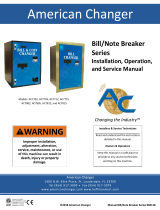
GBA Global Bill Acceptors GBA ST2 Operation Manual
Page 15 of 32 Astrosys International Ltd
October 2011
GBA ST2 Operations Manual v3 00.doc
The memory device should be a conventional USB memory device (i.e. with no novelty features),
formatted by Windows in a FAT format, not NTFS. To find out what format has been used, in
Windows Explorer select the device, right click and select “Properties”. On the “General” tab, the
type should be described as “Removable Device” and file system as “FAT”. Devices with smaller
capacities tend to work more reliably. Also the files must not be encrypted in any way.
5.3.2 File location on the memory device
The validator files should be stored in the root directory of the memory stick. This will appear as
“F:\” or similar letter in “My Computer” on a Windows™ PC. The files should not be put in any
folder, as the validator will not find them. Older and smaller devices have a limit on how many
files can be stored in the root directory (typically 512).
In the root directory you can store one firmware file, one dataset file and one configuration file
that matches the country code of the dataset. A Setup USB wizard tool is available within the GBA
Talk PC software to help you with this. It is not necessary to have all of these files. You can, for
instance, just have a new configuration file on the device and just that will be loaded.
5.3.3 Procedure
1. When the validator detects that a USB device is connected, it will attempt to identify it. If it
can successfully identify it as a memory device, it will then check it, otherwise an error is
given.
2. While the validator is reading the memory device, the diagnostic LED will flash
orange/green alternately. The speed of flashing will reflect the speed at which the
individual device communicates.
3. The validator then searches the root directory for a firmware file (this has the suffix “phy”).
If it finds one, it then checks the firmware version number. If the version number is
different from the current firmware (whether higher or lower) it will load that firmware
and then restart. Once it has restarted it will check the memory device for other files.
4. If more than one firmware file is found, the validator stops reading the memory device and
goes into an error state.
5. If it finds no firmware files, it proceeds directly to the next stage.
6. It next checks for a dataset file (suffix “stx”) and loads that. The dataset file name should
be in the form “ST2 06 N0419100.stx”. Again, if there is more than one dataset file, the
validator will stop reading and go into an error state. Also, if the validator determines that
the dataset format is not compatible with the current firmware version, it will not
download the dataset.
7. Once the dataset is loaded, the validator then looks for a corresponding configuration file.
The file name will be in the form “06_201_M00.xml”. The first 2 characters are the
currency code and must match the second block of characters in the dataset filename.
8. Again, if the validator finds more than one configuration file for that currency, it will enter
an error state.
9. Note that dataset and configuration files are issued by AstroSystems with the correct
naming convention names.




















